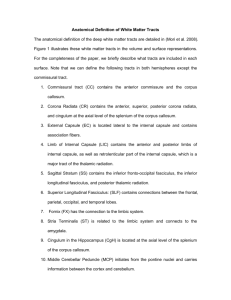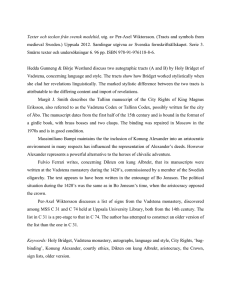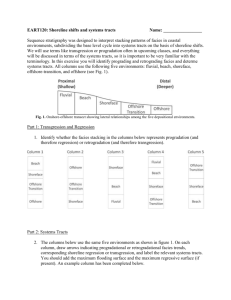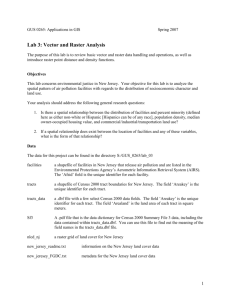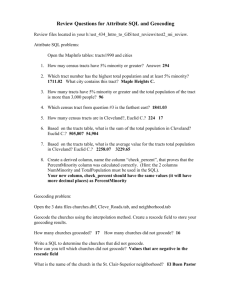_
advertisement
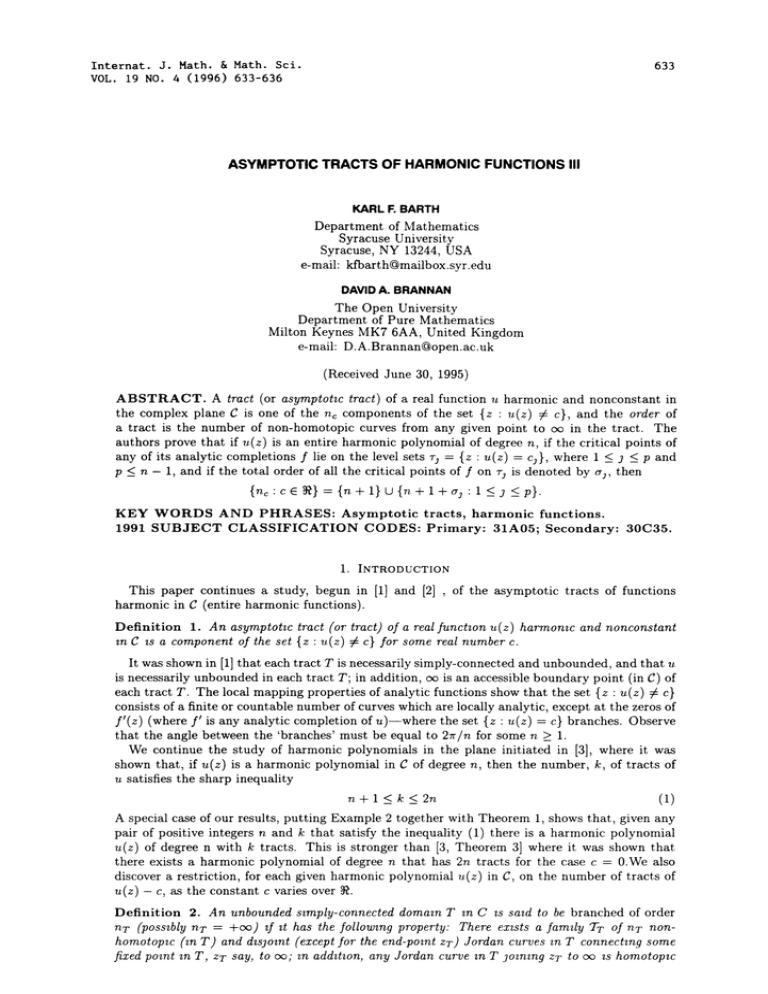
Internat. J. Math. & Math. Sci.
VOL. 19 NO. 4 (1996) 633-636
633
ASYMPTOTIC TRACTS OF HARMONIC FUNCTIONS III
KARL F. BARTH
Department of Mathematics
Syracuse University
Syracuse, NY 13244, USA
e-mail: kfbarth@mailbox.syr.edu
_
DAVID A. BRANNAN
The Open University
Department of Pure Mathematics
Milton Keynes MK7 6AA, United Kingdom
e-mail: D.A.Brannan@open.ac.uk
(Received June 30, 1995)
ABSTRACT. A tract (or asymptotic tract) of a real function u harmonic and nonconstant in
the complex plane C is one of the nc components of the set {z u(z) # c}, and the order of
a tract is the number of non-homotopic curves from any given point to oc in the tract. The
authors prove that if u(z) is an entire harmonic polynomial of degree n, if the critical points of
any of its analytic completions f lie on the level sets -3
{z u(z) c3}, where _< 3 -< P and
p n 1, and if the total order of all the critical points of f on T is denoted by a3, then
{nc’C6 N} {n+l}U{n+l+a" 1_<3 _<p}.
KEY WORDS AND PHRASES: Asymptotic tracts, harmonic functions.
1991 SUBJECT CLASSIFICATION CODES" Primary: 31A05; Secondary: 30C35.
1. INTRODUCTION
This paper continues a study, begun in
harmonic in C (entire harmonic functions).
Definition 1.
[1]
and
[2]
of the asymptotic tracts of functions
An asymptotic tract (or tract) of a real function u(z) harmonzc and nonconstant
C zs a component of the set {z u(z) c} for some real number c.
It was shown in [1] that each tract T is necessarily simply-connected and unbounded, and that u
is necessarily unbounded in each tract T; in addition,
is an accessible boundary point (in C) of
each tract T. The local mapping properties of analytic functions show that the set {z u(z) # c}
consists of a finite or countable number of curves which are locally analytic, except at the zeros of
f’(z) (where f’ is any analytic completion of u)--where the set {z "u(z) c} branches. Observe
that the angle between the ’branches’ must be equal to 2r/n for some n _> 1.
We continue the study of harmonic polynomials in the plane initiated in [3], where it was
shown that, if u(z) is a harmonic polynomial in C of degree n, then the number, k, of tracts of
u satisfies the sharp inequality
n
n
+ <_ k _<
2n
(1)
A special case of our results, putting Example 2 together with Theorem 1, shows that, given any
pair of positive integers n and k that satisfy the inequality (1) there is a harmonic polynomial
u(z) of degree n with k tracts. This is stronger than [3, Theorem 3] where it was shown that
there exists a harmonic polynomial of degree n that has 2n tracts for the case c
0.We also
discover a restriction, for each given harmonic polynomial u(z) in C, on the number of tracts of
u(z) c, as the constant c varies over
.
Definition 2. An unbounded smply-connected domazn T n C s sad to be branched of order
/oc) zf zt has the following property: There exists a family TT of nT nonnT (possibly nT
homotopzc (n T) and dzs.oznt (except for the end-point zT) Jordan curves zn T connectzng some
fixed point zn T, zT say, to cx) zn addztzon, any Jordan curve zn T joining zT to cx) zs homotopzc
ASYMPTOTIC TRACTS OF HARMONIC FUNCTIONS III
634
(zn T) to one of the elements of ?-T.
say that T zs finitely branched; ]’n T
If nT
+o0,
1, we say that T zs unbranched" ] "T < +oo, we
say that T s infinitely-branched.
We
2. NUMBERS OF TRACTS
Let l(z) be an
entire harmonic
polynomial of degree
..
Then, if
z
re
’, we have that
a,rncos(nt9 + 0) + O(r’-l), where a, :/: 0.
(2)
It follows that near oo there must be on {z Izl
r} at least n arcs (each of angular length
about /n) on which u(z) > 0, and at least n arcs (each of angular length about 7/n) on which
u(z) < 0. Since u is a polynomial of degree n and so can have at most 2n zeros on {z "[z r},
u(z)
it follows that for sufficiently large r there are precisely n arcs of each type. Also, it is easy to
prove that the boundaries separating the 2n regions comprising {z "[z
r, ,(z) # 0} tend to
radial lines of angular separation /n as r
+oo.
We will denote by nc the number of components of the set {z ,(z) c 0}. It will be useful
to examine how n varies with c. For sufficiently large r, the set {z "lzl > R} {z "u(z) :/: 0}
consists of precisely 2n unbounded disjoint domains. Then, for such an r, we define
M
+ max{,(z)" Iz <_ r}.
(3)
{z ",(z) M > 0}
It follows that the set {z "u(z)- M # 0} has exactly n components in which
and exactly one component in which {z "u(z) M < 0}. Thus .M
+ 1. Also, it follows
from the Phragmen-Lindelhrf Principle that n n + when c > M. We now look at how n=
varies as c decreases from the value M. The components (tracts) of {z ,(z)
c # 0} vary
continuously with c, in terms of kernel convergence. Hence, as c decreases, n is an integer and
varies continuously with c (hence remains constant)-- except at those values of c for which a
critical point of the analytic completion of u lies on the set {z u(z)
c}.
Now two tracts of u(z) c in which u(z) c has opposite signs can never lie in a single tract
of u(z) Cl, for Cl # c, since u is unbounded in any tract; however their boundaries may meet
in a point or in an arc. No two tracts of u(z) c can have the property that their boundaries
meet in a set with more than one component- for, if they did, then there would be a bounded
(non-empty) domain on whose boundary u(z) c, and so we would have u(z) c in C.
Suppose that T1 and T are two tracts of u(z)- c in which u(z) -c > 0; we will call such tracts
upper tracts (for the value c). (Lower tracts are defined similarly.) It may be that
However we cannot have a situation where OT OT contains an arc in C, by the Maximum
Principle. It follows, then, that, if OT meets OT2, the set OT1 OT must be a singleton.
If T1 and T2 are both upper tracts or both lower tracts for which OT1 OT2 {zo}, then there
must exist an equal number of upper and lower tracts whose boundaries contain zo. Since zo
must thus be a critical point of any analytic completion of u, there can be at most (n 1) such
points zo (since u is a polynomial of degree n). Note also that, as c decreases, the upper tracts
individually increase in size. Hence their total number must decrease as c decreases.
Our main result in this Section is the following.
"
=-
Theorem 1. Let u(z) be an entzre harmonzc polynomzal of degree n. Let the cmtzcal poznts o/
any of zts analytzc completions f he on the level sets T
{z u(z) c}, where <_ <_ p
and p <_ n 1, and let the total order of all the cmtzcal points of f on T be denoted by a. (In
n
partzcular,
1.) Then {no" c
E=
Proof. Let f
be any analytic completion of u.
-
Case 1. All the critical points of f lie on different level sets for u.
Assume first that all the critical points of f are simple; then we may choose our notation so
that they lie on the level sets
{z "u(z) c}, _< 2 _< n 1, where Cl > c > > c,_1.
M (see (3)), we have
Then, by the previous comments, for c > Cl (for example, when c
n n + and there are n upper tracts of u and one lower tract. Next, n n + 2 and there
are, for the value c Cl, n upper tracts and two lower tracts (the lower tract has ’split’ in two).
Finally, for c > c > c, we have n n + 1, and there are (n- 1) upper tracts (two upper tracts
have ’combined’) and 2 lower tracts.
As c decreases further, a similar argument holds for each c in turn, 2 _< 2
1. For
n + and there are (n + 1-2) upper tracts and 2 lower tracts; when
c_1 > c > c, we have n
c
n + 2 and there are (n +
2) upper tracts and (2 + 1) lower tracts; and,
c, we have
for c > c > c+ (with the convention that c, -o), we have
upper tracts and ( + 1) lower tracts.
-<
n
K. F. BARTH AND D. A. BRANNAN
635
Assume next that the critical points of f are not necessarily simple. First, suppose that the
level set {z l(z)
cj}, for some particular value of j, contains a critical point of f (at z
where f’ has a zero of order bj).Let I be an open interval of that contains c but contains no
other c’s corresponding to critical points of f Then, for a sufficiently small neighborhood/ of
z there are (2b + 2) tracts of u(z) c that meet H, namely (b + 1) upper tracts and (b + 1)
lower tracts. However, when c > cj, c E I and c- c is sufficiently small, there are only (b + 2)
tracts of u(z) c that meet H, namely (b + 1) upper tracts and lower tract; similarly, when
c < ca, c E I and c
c is sufficiently small, there are (b + 2) tracts of l(z)
c that meet
namely (bj + 1) lower tracts and upper tract.
Now consider the level set {z u(z)
c} for an arbitrary c. Since, except for values of c
corresponding to critical points of f (and even then locally only in small neighborhoods of the
critical points themselves) the tracts vary continuously with c (in the sense of kernel convergence),
it follows from the above argument that there is some number N such that, for Ic-cl sufficiently
small and non-zero, we have nc N + whereas ncj
N + + b. But nM n q- 1, so that we
must have N n. This completes the proof of Case of the theorem.
Case 2. More than one critical point of f lies on a given level set for u.
Assume first that, for some c, the level set {z: u(z) c} contains just two branch points,
and z2, of orders bl and b2 respectively, and that zl and z2 lie on different components, C and
C2 respectively, of {z u(z) cj}; thus C1 [q C2 0. It follows that there exists some Jordan
curve from o to oo that separates C1 from C2; this curve can be chosen to lie either in a single
component of {z u(z) > c} or in a single component of {z u(z) < ca}. By considering the
local behavior of u near z and z2, and by using the fact that components of {z u(z) d # 0}
vary continuously with d (except when their boundaries coalesce), it follows that, when
is sufficiently small, we have nd n q- and n
(n + 1) + b + b2. A similar argument works
in the case of more than two branch points on a single level set of u, so long as each such branch
point lies on a different component of that level set.
Assume next that, for some %, the level set {z u(z) ca} contains just two branch points, z
and z2, of orders bl and b2 respectively (corresponding to zeros of f of these orders), and that
Zl and z2 lie on the same component, C, of {z u(z)
c} Then there is a Jordan subarc F of
C joining zl to z2; let z’ be any interior point of this subarc. Since C cannot contain any closed
Jordan curves, it follows that there are precisely two tracts, T1 and T2, say, of u(z) c that
have F- {Zl, Z} as part of their boundaries; we may assume that u(z) > c in T and so that
u(z) < c in T2. Similar considerations also show that there is a Jordan curve J in T
that joins z’ to o inside T1, and a Jordan curve J2 in T2 W {z’} that joins z’ to o inside T2.
We define J J J. Then J plays the same role as J did earlier (when it separated C1
from C2), and a similar argument to the previous one shows that
nd=
n + 1,
if d # c, and Id
n+l+(b+b2), if d=%.
%1 sufficiently small,
(4)
Again a similar argument can be used even when there are more than two branch points on the
same component of the level set.
The result of this theorem is stronger than [3, Theorem 1], where it was shown that {n c }
is a subset of {n + 1, n + 2,
2n}.
Notice that for the function Ul(Z) Re(z ) we have no 2n and n n + 1, and that in fact
{n
c
}
{n + 1, 2n}.
The next two examples show that, while this particular function
concerning the range of possible
is extremal in a certain sense, the conclusion of Theorem
values of n (as c varies) is best-possible.
u
Example 1. There exists a harmonic polynomial u of degree n for whzch {n c
}
{n + 1, n + 2}, and all the cmtcal points of any analytic completzon f of u are smple and le on
dfferent level sets of u.
Let u(z)
f (z)
=_ z
Re(z
-
Az), for a complex number A yet to be specffied. The analytic completion
nz ’A 0; that is, where
Az of u has critical points where
z=z=
exp
n-l]’
ASYMPTOTIC TRACTS OF HARMONIC FUNCTIONS III
636
Now u(zk) Re(kA(1-’));and it follows that,if A is chosen with [A[
and with argA not a
rational multiple of 2r, then all the values of {u(zk)}’-1 are distinct. Thus has the desired
properties.
Example 2. Let p be an znteger, such that <_ p <_ n- 1, and let bl, b2, bp be any integers ,n
bj n 1. There exzsts a harmonzc polynomzal ,(z) o]" degree n wzth
[1, n 2]/or whzch
the propertzes that any analytzc completzon ]" o]’u has cmtzcal poznts of orders bl, b2,
bp, and
that all these cmtzcal poznts lze on dzfferent level sets o]’1. Hence (from Theorem 1)
-P=I
{nc"
}
{n 4-1} U {n 4- 14-bj _3 -P}.
First, let ]’1 be the polynomial given by fl(0) 0 and
f;(z) (z 1)b’(z a2)buz (n-1)-(b’+b=),
cE
(6)
where a2 is chosen to be either i or to be very close to 1/2; in particular, we make our choice of
Refl(Z). It follows from Rolle’s Theorem that the
a2 to ensure that Ul(1) :/: 0, where u(z)
points and a2 lie on different level sets of u.
Next, let f2 be the polynomial given by f2(0) 0 and
f(z)
(z
1)b’(z a2)b:(z a3)b’z (n-1)-(b’+bu+ba),
(7)
where a3 is positive but small. By continuity arguments (on f) we see that we may choose a
sufficiently near to 0 that and a2 lie on different level sets of u2(z) _= Ref2(z).
We have to check that a3 can be chosen so that aa lies on a different level set of 2 from those
that contain either or a2. But, if a3 is sufficiently small, we have that
u2(1)
u(a2)
(t
1)b(t a)bt (’-1-(+1 et,
, f(t- 1)b(t a)bt (n-1)-(b+b) et,
.Io
()
and
(_
u2(a3)
),/=/(a)=()(-</=)/f0 (1- )(-)-(/=//d
hence, for all sufficiently small a3, the values of u2(1), u2(a2) and u2(aa) are all distinct.
A similar argument shows, after a further (p- 3) steps, that the polynomial u(z) Ref(z),
where
f (0)
0 and
f’(z)
(z
1)( )(z )(z )"
(z
a)
,
(0)
and the sequence {%}=3 decreases to 0 sufficiently quickly, has the desired properties.
Finally, as was mentioned in the Introduction, suppose n and k are positive integers such that
2n. If k n + 1, we see from Example that there exists a harmonic polynomial
n + 1
k
u(z) such that nc {n+ 1,n+2}. Ifn+ < k 2n and weset bl k-(n+ 1) and b2 2n-k,
Example 2 shows that there exists a harmonic polynomial u(z) such that
{}
,
{n + 1, n +
{ + ,n + + l,n + + }
ACKNOWLEDGMENT. The first author gratefully acknowledges support from the Science
and Engineering Research Council of the United Kingdom.
REFERENCES
1. K. F. Barth and D. A. Brannan, Asymptotzc tracts of harmonic functzons I, Acad. Sci. Fenn.
Series A. I. Math. 11 (1986), 215-232.
2.
Asymptotic tracts of harmonic functzons II, Proc. Edinburgh Math. Soc. 38 (1995),
35-52.
3. W. K. Hayman D. A. Brannan, W. H. J. Fuchs and
polynomials m the plane, Proc. London Math. Soc.
(. Kuran, A charactemsaton of harmonic
(3) 32 (1976), 213-229.
